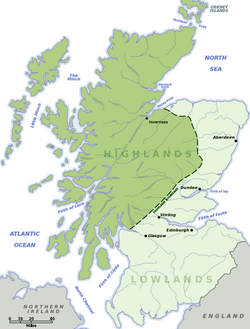
Back Skotse Hoogland Afrikaans Hēahland ANG مرتفعات إسكتلندا Arabic Tierres Altes d'Escocia AST Паўночна-Шатландскае нагор’е Byelorussian Северошотландска планинска земя Bulgarian Uheldirioù Bro-Skos Breton Škotsko visočje BS Terres altes d'Escòcia Catalan Skotská vysočina Czech
Highlands
| |
|---|---|
 Lowland–Highland divide | |
 | |
| Seat | Inverness |
| Population | |
• Estimate (2019) | 600,000 |
| [citation needed] | |
| Demonym | Highlander |
| Time zone | GMT/BST |
The Highlands (Scots: the Hielands; Scottish Gaelic: a' Ghàidhealtachd [ə ˈɣɛːəl̪ˠt̪ʰəxk], lit. 'the place of the Gaels') is a historical region of Scotland.[1][failed verification] Culturally, the Highlands and the Lowlands diverged from the Late Middle Ages into the modern period, when Lowland Scots language replaced Scottish Gaelic throughout most of the Lowlands. The term is also used for the area north and west of the Highland Boundary Fault, although the exact boundaries are not clearly defined, particularly to the east. The Great Glen divides the Grampian Mountains to the southeast from the Northwest Highlands. The Scottish Gaelic name of A' Ghàidhealtachd literally means "the place of the Gaels" and traditionally, from a Gaelic-speaking point of view, includes both the Western Isles and the Highlands.

The area is very sparsely populated, with many mountain ranges dominating the region, and includes the highest mountain in the British Isles, Ben Nevis. During the 18th and early 19th centuries the population of the Highlands rose to around 300,000, but from c. 1841 and for the next 160 years, the natural increase in population was exceeded by emigration (mostly to Canada, the United States, Australia and New Zealand, and migration to the industrial cities of Scotland and England.)[2]: xxiii, 414 and passim The area is now one of the most sparsely populated in Europe. At 9.1/km2 (24/sq mi) in 2012,[3] the population density in the Highlands and Islands is less than one seventh of Scotland's as a whole.[3]
The Highland Council is the administrative body for much of the Highlands, with its administrative centre at Inverness. However, the Highlands also includes parts of the council areas of Aberdeenshire, Angus, Argyll and Bute, Moray, North Ayrshire, Perth and Kinross, Stirling and West Dunbartonshire.
The Scottish Highlands is the only area in the British Isles to have the taiga biome as it features concentrated populations of Scots pine forest:[4] see Caledonian Forest. It is the most mountainous part of the United Kingdom.
- ^ "Highlands | region, Scotland, United Kingdom". Encyclopædia Britannica. Retrieved 10 May 2017.
- ^ Richards, Eric (2000). The Highland Clearances People, Landlords and Rural Turmoil (2013 ed.). Edinburgh: Birlinn Limited. ISBN 978-1-78027-165-1.
- ^ a b "Highland profile – key facts and figures". The Highland Council. Retrieved 2 June 2014.
- ^ "Taiga | Plants, Animals, Climate, Location, & Facts | Britannica". www.britannica.com. Retrieved 4 May 2023.